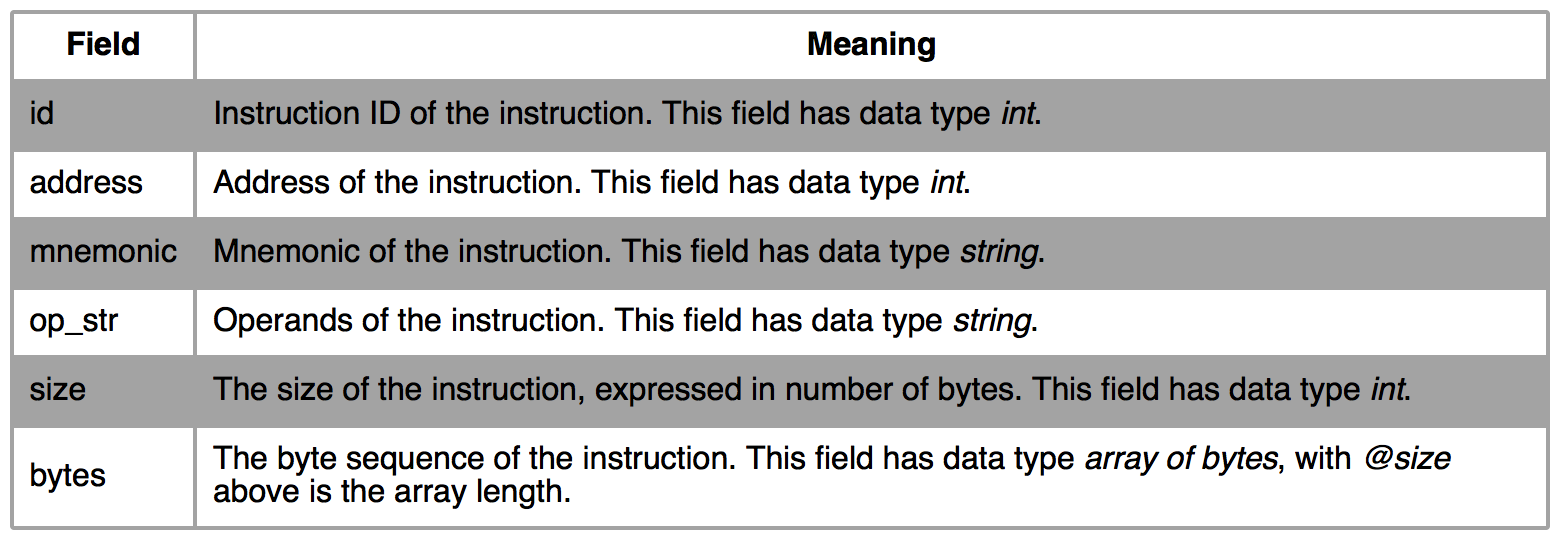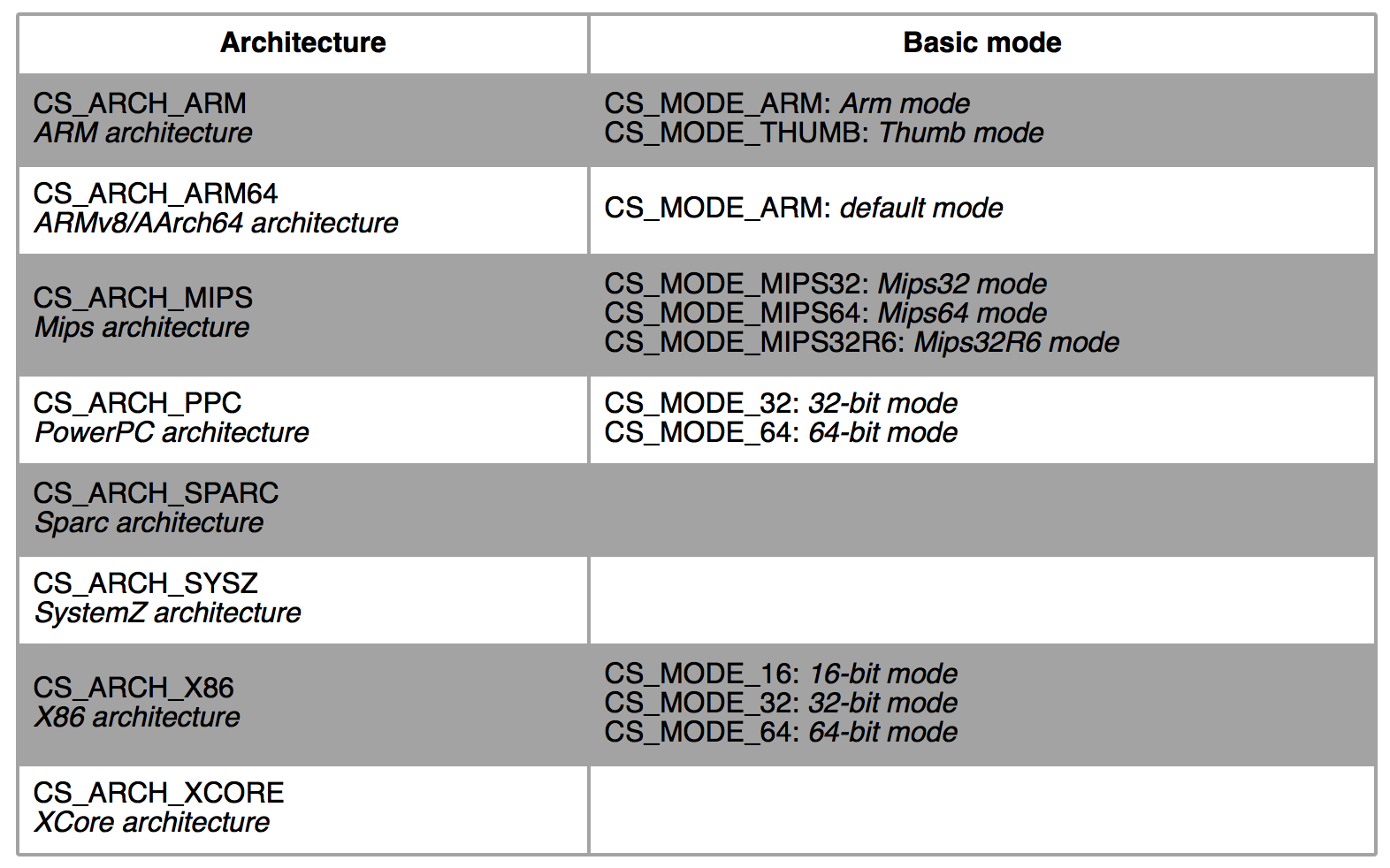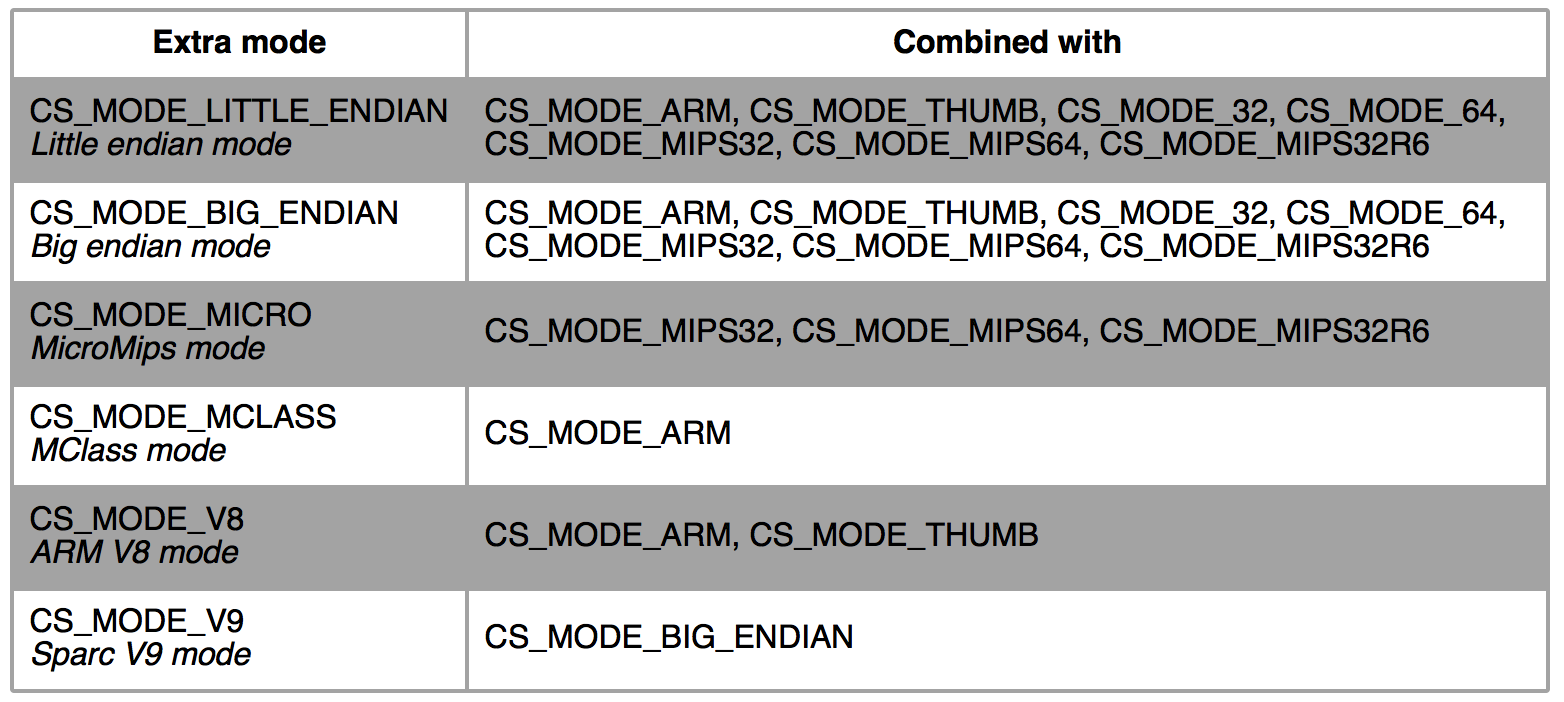C tutorial for Capstone
Example code
This short example shows how the Capstone API looks and how easy it is to disassemble binary code with it. There are more APIs than those used here, but these are all we need to get started.
1
2
3
4
5
6
7
8
9
10
11
12
13
14
15
16
17
18
19
20
21
22
23
24
25
26
27
28
29
30
31
32
33
/* test1.c */
#include <stdio.h>
#include <inttypes.h>
#include <capstone/capstone.h>
#define CODE "\x55\x48\x8b\x05\xb8\x13\x00\x00"
int main(void)
{
csh handle;
cs_insn *insn;
size_t count;
if (cs_open(CS_ARCH_X86, CS_MODE_64, &handle) != CS_ERR_OK)
return -1;
count = cs_disasm(handle, CODE, sizeof(CODE)-1, 0x1000, 0, &insn);
if (count > 0) {
size_t j;
for (j = 0; j < count; j++) {
printf("0x%"PRIx64":\t%s\t\t%s\n", insn[j].address, insn[j].mnemonic,
insn[j].op_str);
}
cs_free(insn, count);
} else
printf("ERROR: Failed to disassemble given code!\n");
cs_close(&handle);
return 0;
}
To compile this file, we need a Makefile like below.
# capstone library name (without prefix 'lib' and suffix '.so')
LIBNAME = capstone
test1: test1.o
${CC} $< -O3 -Wall -l$(LIBNAME) -o $@
%.o: %.c
${CC} -c $< -o $@
Readers can get this sample code in a zip file here. Compile and run it as follows.
$ make
cc -c test1.c -o test1.o
cc test1.o -O3 -Wall -lcapstone -o test1
$ ./test1
0x1000: push rbp
0x1001: mov rax, qword ptr [rip + 0x13b8]
The C sample is intuitive, but just in case, readers can find below the explanation for each line of test1.c.
-
Line 6: Include header file capstone.h before we do anything.
-
Line 8: Raw binary code we want to disassemble. The code in this sample is in hex mode.
-
Line 12: Declare a handle variable of the type csh. This handle will be used at every API of Capstone.
-
Line 13: Declare insn, a pointer variable of the type cs_insn, which points to a memory containing all disassembled instructions.
-
Line 16: Initialize Capstone with function cs_open(). This API accepts 3 arguments: the hardware architecture, hardware mode and pointer to handle. In this sample, we want to disassemble 64-bit code for X86 architecture. In return, we have the handle updated in variable handle. This API can fail in extreme cases, so our sample verifies the returned result against the error code CS_ERR_OK.
-
Line 18: Disassemble the binary code using the API cs_disasm() with the handle we got from the cs_open(). The 2nd & 3rd arguments of cs_disasm() is the binary code to be disassembled and its length. The 4th argument is the address of the first instruction, which is 0x1000 in this case. If we want to disassemble all the code until either there is no more code, or it encounters a broken instruction, use 0 as the next argument. In return, this API gives back a dynamically allocated memory in the last argument insn, which can be used to extract out all the disassembled instructions in the next steps. The result of cs_disasm() is the number of instructions successfully disassembled.
-
Line 19: Check if we really have some disassembled instructions at the output of cs_disasm()
-
Line 21 ~ 24: Print out all disassembled instructions with their addresses, mnemonics and operands. The structure cs_insn exposes all the internal information about the disassembled instruction we are looking at. Some of the most used fields of this structure are presented below.

-
Line 26: Free dynamic memory allocated by cs_disasm() with the API cs_free(). The 2nd argument passed to cs_free() is the number of disassembled instructions returned by cs_disasm() in line 18.
-
Line 30: Close the handle when we are done with the API cs_close().
2. Architectures and modes
At the moment, Capstone supports 8 hardware architectures with corresponding hardware modes, as follows.

Besides, depending on cases, there are few more modes to be combined with basic modes above.

The way to combine extra modes with basic modes is to use the operand +. For example, the sample below initializes Capstone for Mips64 in little endian mode.
cs_open(CS_ARCH_MIPS, CS_MODE_MIPS64 + CS_MODE_LITTLE_ENDIAN, &handle);3. More architecture-independent internal data of the disassembled instruction
By default, Capstone do not generate details for disassembled instruction. If we want information such as implicit registers read/written or semantic groups that this instruction belongs to, we need to explicitly turn this option on, like in the sample code below.
csh handle;
cs_open(CS_ARCH_X86, CS_MODE_64, &handle);
cs_option(handle, CS_OPT_DETAIL, CS_OPT_ON); // turn ON detail feature with CS_OPT_ON
However, keep in mind that producing details costs more memory, complicates the internal operations and slows down the engine a bit, so only do that if needed. If this is no longer desired, we can always reset the engine back to default state at run-time with similar method.
cs_option(handle, CS_OPT_DETAIL, CS_OPT_OFF); // no longer generate details
Details produced by Capstone provides access to a lot more internal data of the disassembled instruction than the fields introduced in the last sections. Note that these data are all architecture-independent.
The sample below shows how to extract out details on implicit registers being read by instructions, as well as all the semantic groups this instruction belongs to in some ARM binary.
1
2
3
4
5
6
7
8
9
10
11
12
13
14
15
16
17
18
19
20
21
22
23
24
25
26
27
28
29
30
count = cs_disasm(handle, CODE, sizeof(CODE)-1, 0x1000, 0, &all_insn);
if (count > 0) {
size_t j;
int n;
for (j = 0; j < count; j++) {
cs_insn *i = &(all_insn[j]);
if (i->id != ARM_INS_BL && i->id != ARM_INS_CMP)
continue;
printf("0x%"PRIx64":\t%s\t\t%s // insn-mnem: %s\n",
i->address, i->mnemonic, i->op_str,
cs_insn_name(handle, i->id));
cs_detail *detail = i->detail;
if (detail->regs_read_count > 0) {
printf("\tImplicit registers read: ");
for (n = 0; n < detail->regs_read_count; n++) {
printf("%s ", cs_reg_name(handle, detail->regs_read[n]));
}
printf("\n");
}
if (detail->groups_count > 0) {
printf("\tThis instruction belongs to groups: ");
for (n = 0; n < detail->groups_count; n++) {
printf("%u ", detail->groups[n]);
}
printf("\n");
}
}
}
Readers might already figure out how the code above work, as it is simple enough:
-
Line 6: type-cast inspected instruction to variable i for simplicity.
-
Line 7: In this example, we only care about some instructions, which is either bl or cmp, and ignore everything else. All the constant numbers can be found in file arm.h in the same directory of the header file capstone.h.
-
Line 13: Type-cast detail information (of data type cs_detail) to a variable named detail for brevity.
-
Line 14: Check if this instruction implicitly reads any registers. If so, next block prints out all these register names.
-
Line 17: While we can simply print out the register ID (which has data type int), it is more friendly to print out its register name instead. This can be done with the API cs_reg_name(), which accepts the register ID as its 2nd argument.
-
Line 22 ~ 26: Check if this instruction belongs to any semantic group. If so, print out all group ID. Similarly, we can find all the group ID in the header file arm.h.
The output of the above sample is like below.
0x1000: bl #0x104c // insn-name: BL
Implicit registers read: pc
This instruction belongs to groups: 20
0x101c: cmp r3, #0 // insn-name: CMP
This instruction belongs to groups: 204. Architecture-dependent details
Structure cs_detail has an union structure enabling access to architectured details in arm, arm64, mips, ppc or x86 structures, depending on the current disassembling hardware mode. Refer to corresponding header file arm.h, arm64.h, mips.h, ppc.h & x86.h for further details on what information Capstone can provide.
The sample below demonstrates how to extract the details of instruction operands of ARM64 code.
1
2
3
4
5
6
7
8
9
10
11
12
13
14
15
16
17
18
19
20
21
22
23
24
25
26
27
28
29
30
31
32
33
34
35
36
37
38
39
40
41
42
43
44
45
46
// assume "insn"is a pointer variable to structure cs_insn
cs_detail *detail = insn->detail;
if (detail->arm64.op_count)
printf("\tNumber of operands: %u\n", detail->arm64.op_count);
for (n = 0; n < detail->arm64.op_count; n++) {
cs_arm64_op *op = &(detail->arm64.operands[n]);
switch(op->type) {
case ARM64_OP_REG:
printf("\t\toperands[%u].type: REG = %s\n", n, cs_reg_name(handle, op->reg));
break;
case ARM64_OP_IMM:
printf("\t\toperands[%u].type: IMM = 0x%x\n", n, op->imm);
break;
case ARM64_OP_FP:
printf("\t\toperands[%u].type: FP = %f\n", n, op->fp);
break;
case ARM64_OP_MEM:
printf("\t\toperands[%u].type: MEM\n", n);
if (op->mem.base != ARM64_REG_INVALID)
printf("\t\t\toperands[%u].mem.base: REG = %s\n", n, cs_reg_name(handle, op->mem.base));
if (op->mem.index != ARM64_REG_INVALID)
printf("\t\t\toperands[%u].mem.index: REG = %s\n", n, cs_reg_name(handle, op->mem.index));
if (op->mem.disp != 0)
printf("\t\t\toperands[%u].mem.disp: 0x%x\n", n, op->mem.disp);
break;
case ARM64_OP_CIMM:
printf("\t\toperands[%u].type: C-IMM = %u\n", n, op->imm);
break;
}
if (op->shift.type != ARM64_SFT_INVALID && op->shift.value)
printf("\t\t\tShift: type = %u, value = %u\n", op->shift.type, op->shift.value);
if (op->ext != ARM64_EXT_INVALID)
printf("\t\t\tExt: %u\n", op->ext);
}
if (detail->arm64.cc != ARM64_CC_INVALID)
printf("\tCode condition: %u\n", detail->arm64.cc);
if (detail->arm64.update_flags)
printf("\tUpdate-flags: True\n");
if (detail->arm64.writeback)
printf("\tWrite-back: True\n");
The code looks a bit complicated, but actually pretty simple:
-
Line 2: Assume we already have a pointer to cs_insn structure. This line casts the details to a variable named detail for simplicity.
-
Line 3: Check if this instruction has any operands to print out.
-
Line 9 ~ 11: If this operand is register (reflected by type ARM64_OP_REG), then print out its register name with the API cs_reg_name().
-
Line 12 ~ 14: If this operand is immediate (reflected by type ARM64_OP_IMM), then print out its numerical value.
-
Line 15 ~ 17: If this operand is real number (reflected by type ARM64_OP_FP), then print out its numerical value.
-
Line 18 ~ 26: If this operand is memory reference (reflected by type ARM64_OP_MEM), then print out its base/index registers, together with offset value.
-
Line 27 ~ 29: If this operand is of type C-IMM (coprocessor register type, reflected by ARM64_OP_CIMM), then print out its index value.
-
Line 32 ~ 36: If this operand uses shift or extender, print out their value.
-
Line 39 ~ 40: Print out the code condition of this instruction if relevant.
-
Line 42 ~ 43: If this instruction update flags, print out that.
-
Line 45 ~ 46: If this instruction writes back its value afterwards, print out that.
The output of the above sample is like below.
0x38: ldr w1, [sp, #8]
Number of operands: 2
operands[0].type: REG = w1
operands[1].type: MEM
operands[1].mem.base: REG = sp
operands[1].mem.disp: 0x8
0x3c: csneg x0, x1, x1, eq
Number of operands: 3
operands[0].type: REG = x0
operands[1].type: REG = x1
operands[2].type: REG = x1
Code condition: 1
0x40: add x0, x1, x2, lsl #2
Number of operands: 3
operands[0].type: REG = x0
operands[1].type: REG = x1
operands[2].type: REG = x2
Shift: type = 1, value = 25. Run-time options
Besides the CS_OPT_DETAIL option previously introduced, Capstone can customize the engine at run-time, allowing us to set the assembly syntax or dynamically change engine’s mode with the same API cs_option().
5.1 Syntax option
By default, X86 assembly outputs in Intel syntax. To switch to AT&T syntax instead, we can simply set syntax option using the option CS_OPT_SYNTAX with cs_option() like below.
csh handle;
cs_open(CS_ARCH_X86, CS_MODE_64, &handle);
cs_option(handle, CS_OPT_SYNTAX, CS_OPT_SYNTAX_ATT); // CS_OPT_SYNTAX_ATT represents AT&T syntax
In case we want to return to Intel syntax, we can reset the syntax in the similar way:
cs_option(handle, CS_OPT_SYNTAX, CS_OPT_SYNTAX_INTEL); // CS_OPT_SYNTAX_INTEL indicates Intel syntax5.2 Dynamically change disassemble mode at run-time
From version 2.0, we can dynamically change the engine’s mode with cs_open() at run-time thanks to a new option CS_OPT_MODE.
This is useful for example with Arm, where we might frequently switch between Arm & Thumb modes without having to create a new engine. This also happens with X86, where we might want to switch back and forth between protected-mode & real-mode code.
Below sample shows how CS_OPT_MODE can be used to switch back and forth between Arm & Thumb modes at run-time.
cs_open(CS_ARCH_ARM, CS_MODE_ARM, &handle);
// from now on disassemble Arm code ....
cs_option(handle, CS_OPT_MODE, CS_MODE_THUMB); // dynamically change engine's mode at run-time
// from now on disassemble Thumb code ....
cs_option(handle, CS_OPT_MODE, CS_MODE_ARM); // change back to Arm mode again
// from now on disassemble Arm code again6. Diet engine
From version 2.1, Capstone supports “diet” compilation option to minimize the engine for embedded purpose. The diet engine no longer updates some data fields of the cs_insn struct, so these fields & some related APIs become irrelevant. See this documentation for further information.
7. More examples
This tutorial does not explain all the API of Capstone yet. Please find more advanced examples in source of test_*.c files under directory tests/ in the Capstone source code.
